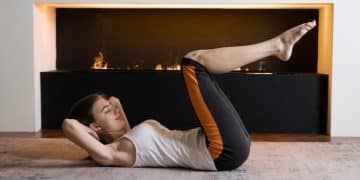Progressive muscle relaxation for sleep: try this simple technique

Progressive muscle relaxation for sleep is a technique that involves tensing and relaxing muscle groups to reduce stress, promote relaxation, and improve sleep quality effectively.
Progressive muscle relaxation for sleep is an effective method to ease your mind and body. Have you ever struggled to fall asleep and felt restless? This technique can help by guiding you to release tension and promote relaxation.
Understanding progressive muscle relaxation
Understanding progressive muscle relaxation is crucial for improving your sleep quality. This technique focuses on tensing and then relaxing different muscle groups in your body, helping you release stress and tension. You might be surprised at how simple it is to incorporate into your nightly routine.
How it works
The process starts with identifying areas where you hold tension, such as your shoulders or neck. By concentrating on these areas, you can reduce physical stress. This is especially beneficial right before bed, as it prepares both your mind and body for a restful night’s sleep.
Steps to practice >
Key benefits
Practicing progressive muscle relaxation offers numerous benefits. It can help manage anxiety, reduce physical pain, and improve your overall mood. Many people find that it shortens the time it takes to fall asleep and increases the quality of sleep.
Incorporating this technique into your nightly routine is simple. Consider spending just 10-15 minutes focusing on your body’s tension, and you’ll likely notice significant improvements in your sleep patterns.
Consistency is essential. The more often you practice, the more effective it becomes.
Steps to practice muscle relaxation

Steps to practice muscle relaxation are essential for effectively reducing tension and preparing for sleep. By following these simple steps, you can incorporate this technique into your nightly routine.
Preparation for relaxation
Start by finding a quiet and comfortable space where you won’t be disturbed. You may choose to lie down on your bed or use a yoga mat on the floor. Make sure to wear loose, comfortable clothing to enhance your relaxation experience.
Begin with deep breathing
Before you start the muscle relaxation process, take a few moments to focus on your breathing. Inhale deeply through your nose for a count of four, then exhale slowly through your mouth for a count of six. This helps calm your mind and body.
Focus on your muscles
Choose one muscle group at a time. Start with your toes and work your way up to your head. Progressive muscle relaxation encourages awareness of your body. By tensing and then relaxing each muscle group, you help release built-up tension.
- Tense each group for about five seconds.
- Then, release and notice the difference.
- Move on to the next muscle group.
This approach allows you to connect with your body and become aware of areas where you hold stress. Try to focus on how your body feels during each step.
Continue this process for about 15 to 20 minutes. When complete, take a moment to assess your overall sense of relaxation. It’s important to practice consistently to maximize the benefits.
Benefits for sleep improvement
Understanding the benefits for sleep improvement through muscle relaxation can greatly enhance your nighttime routines. Applying this technique can not only help you fall asleep faster but also improve the quality of your sleep.
Reduces anxiety and stress
One of the primary benefits is a significant reduction in anxiety and stress levels. When you practice progressive muscle relaxation, the focus on your body helps quiet your racing thoughts. This makes it easier to unwind after a long day.
Promotes deeper sleep
Another major advantage is that it promotes deeper and more restorative sleep. By calming your mind and body, you allow yourself to enter more profound sleep stages. This means you wake up feeling refreshed and energized.
Improves overall well-being
Regular practice leads to improved overall well-being. Not only do you feel better physically, but your mental health benefits as well. People who use this technique often report feeling more balanced and positive.
- Enhances mood and reduces irritability.
- Improves concentration and cognitive function.
- Boosts immune function by lowering stress hormones.
Consistently practicing muscle relaxation not only benefits your sleep but also your life during the day. It’s a simple yet effective tool to help you manage daily stresses.
Embracing these benefits can lead to a healthier lifestyle, promoting better sleep hygiene and overall relaxation. By prioritizing your mental and physical health through these practices, you set the groundwork for brighter days ahead.
Common mistakes to avoid in relaxation

Practicing relaxation techniques can be highly beneficial, but there are common mistakes to avoid in relaxation that can hinder your progress. Being aware of these pitfalls can help you maximize your relaxation practice.
Rushing the process
One major mistake is trying to rush through the relaxation process. It’s vital to take your time and allow yourself to truly unwind. Give yourself at least 15 to 20 minutes each time you practice. When you’re rushed, stress can carry over into your relaxation sessions.
Skipping muscle groups
Another common mistake is skipping over certain muscle groups. Every part of your body plays a role in relaxation. Neglecting areas like your shoulders or neck can lead to missed opportunities for tension release. Focus on each muscle group, from your toes to your head, ensuring a comprehensive approach.
Poor environment
Your environment plays a significant role in effective relaxation. If you’re in a noisy or cluttered space, it can be hard to focus. Create a peaceful environment by choosing a quiet place and minimizing distractions. Consider dimming the lights or using calming scents, such as lavender.
Inconsistent practice
Inconsistency can stall your progress. To truly experience the benefits of progressive muscle relaxation, practice regularly. Set aside dedicated time for relaxation in your daily or weekly routine. This will help establish a habit and make it easier to unwind.
- Set specific times for relaxation each day.
- Keep a relaxation journal to track your practice.
- Customize your techniques to find what works best for you.
Another mistake is not adapting the techniques to your personal needs. Everyone is different, so what works for one person might not work for another. Listen to your body and make adjustments as necessary.
FAQ – Questions About Progressive Muscle Relaxation for Sleep
What is progressive muscle relaxation?
Progressive muscle relaxation is a technique that involves tensing and then relaxing different muscle groups in the body to reduce stress and promote sleep.
How can I implement this technique in my nightly routine?
You can implement this technique by setting aside 15-20 minutes each night to focus on tensing and then relaxing each muscle group from your toes to your head.
Are there any mistakes I should avoid when practicing muscle relaxation?
Yes, avoid rushing the process, skipping muscle groups, practicing in a noisy environment, and being inconsistent with your practice.
What are the benefits of using progressive muscle relaxation for sleep?
The benefits include reduced anxiety and stress, improved sleep quality, and an overall enhancement in your mood and well-being.





